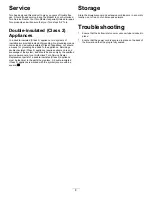
Connecting to a Power Source
The power supply you use with this appliance should be a
residential current device (RCD) with a tripping current of not
more than 30 mA. Use only a CE approved extension cord
recommended for outdoor use. Do not change the appliance or
extension cord plug in any way.
WARNING
If you do not fully seat the extension cord on the
inlet plug, or if the plug and cord do not fit firmly, the
loose plug could lead to overheating and cause a fire,
possibly burning you or others.
•
Ensure that you fully seat the cord on the plug.
•
Check the connection regularly to ensure that the
cord is firmly attached.
•
Do not use a worn-out or loose extension cord.
Extension Cord Length
Minimum Wire Gage
30 m
1.0 mm
2
45 m
2.0 mm
2
Note:
Do not use an extension cord over 45 m.
Important:
Check the extension cord frequently during
use for holes in the insulation. Do not use a damaged
cord. Do not run the cord through standing water or
wet grass.
Secure the extension cord to the blower using the molded in
cord-lock feature.
Starting/Stopping/Adjusting
the Air Speed
Using the Concentrator Nozzle
Accessory
Install the power and concentrator nozzles into the blower tube to
help reach into narrow spaces or to remove matted debris from
hard surfaces.
1.
Blower tube
3.
Concentrator nozzle
2.
Power nozzle
4.
Cord wrap
Using the Oscillator Nozzle
Accessory
Install the oscillator nozzle onto the blower tube to save time
clearing hardscapes. It automatically sweeps the back-and-forth,
creating a wider blowing path with less side-to-side wrist
movement.
Note:
Remove the oscillator nozzle before using the cord
wrap to store the blower.
Using the Blower
The blower is intended for residential use only. Use the blower
outdoors to move debris as needed.
WARNING
The blower can throw debris, possibly causing serious
personal injury to the operator or bystanders.
•
Do not blow hard objects such as nails, bolts, or
rocks.
•
Do not operate the blower near bystanders or pets.
•
Use extra care when cleaning debris from stairs or
other tight areas.
•
Wear safety goggles or other suitable eye
protection, long pants, and shoes.
6
Summary of Contents for 51581
Page 9: ...Notes 9...
Page 10: ...Notes 10...






























